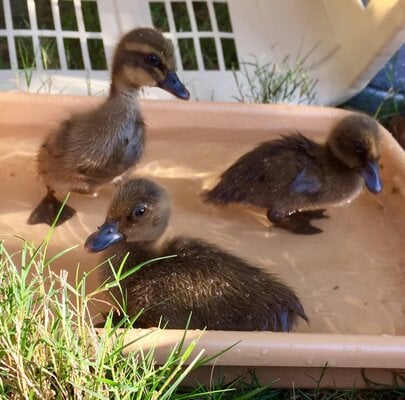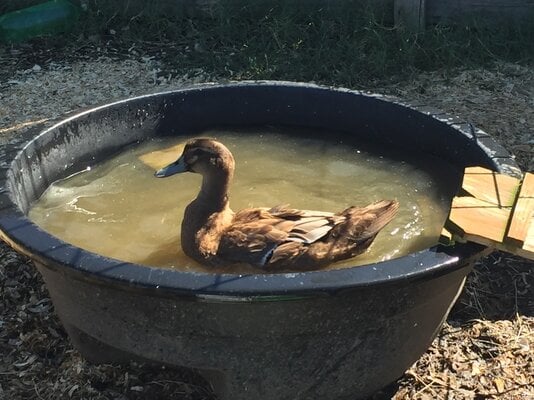You went to the feed store and fell in love with those cute little webbed feet and those adorable faces. Now, you are wondering what gender is my duck? If your duckling is only a few days old, you are probably going to have to wait a few weeks unless you know how to vent sex (in which case you would not be reading this article) or happened to purchase one of the few ducklings which can be sexed right after hatching. If you purchased Welsh Harlequin ducklings, and they are only a couple of days old, their bill color should give you their gender. As you can see in the picture below, female ducklings hatch with a more pink bill.
The males hatch with a much darker bill. But, if Welsh Harlequin ducklings are more than a few days old it may be hard to tell, all of their bills get darker with age. These are the same two female ducklings at about a week old.
There are also sex-linked ducklings such Golden 300 hybrid ducklings. They are mixed, or hybrid ducklings produced my crossing a brown or chocolate drake (male) like a Khaki Campbell with a wild type or black hen (female) like a Silver Welsh Harlequin or a Rouen. The ducklings which are brownish are then females and the darker, more black ducklings are male. The picture below shows the offspring of my Silver Welsh Harlequin hen with my Khaki Campbell drake. The boys are the three darker ducklings.
If your ducklings are not Welsh Harlequins or sex-linked hybrids, you are going to have to wait a few weeks to determine their gender. You can try to guess. Sometimes the males seem to be more friendly and less skittish, but you are just guessing.
Around 3-4 weeks (sometimes as early as 2), females can start to have their voices change. Their peep peep changes. It gets deeper and reminds me of my dog's squeaky toy. It then gets stronger and louder and becomes a real quack. The boys tend to peep for a lot longer and then get raspy, sort of like as if they have a sore throat.
If you have ducks whose genders look different as adults, you might think you have all girls when they first start to get their adult feathers. Don't be fooled. Both males and females look very similar at first. Look at the picture below. This is a picture of my first two ducks, Khaki Campbells, when they were a little over a month old. Their feathers are very similar but you can sometimes see differences and tell their gender. The feathers located above their tails are often different. Males usually get solid, dark feathers and females have lighter, two-toned feathers.
This is a picture of my female Welsh Harlequin at about the same age. Note the two-colored feathers above her tail.
Now you try it. What gender do you think this one is? It is a Khaki/Appleyard mix.
If you guessed male, you are correct. This seems to work with most ducks who are not a solid color. If you still aren't sure what your ducks are you can just keep waiting. In another month they will molt into their breeding plumage. This is the same drake a little over a month later.
By this age drake curls arrive as well. See the two curly feather on his tail. Even if your ducks are all one color, drake curls will be your final clue. And if you have a girl and her quack isn't enough to convince you, she should start laying eggs around 4-5 months.


